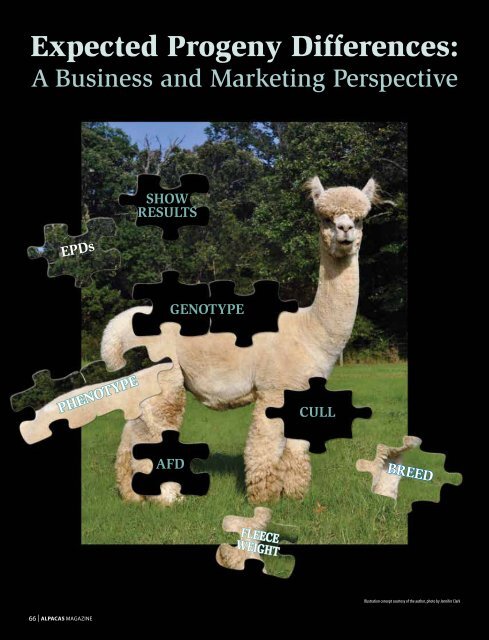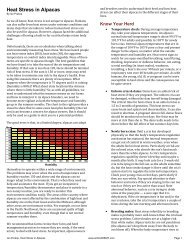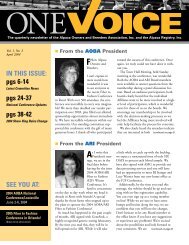download this article as PDF - ariLIST
download this article as PDF - ariLIST
download this article as PDF - ariLIST
Create successful ePaper yourself
Turn your PDF publications into a flip-book with our unique Google optimized e-Paper software.
Expected Progeny Differences:<br />
A Business and Marketing Perspective<br />
SHOW<br />
RESULTS<br />
EPDs<br />
GENOTYPE<br />
PHENOTYPE<br />
CULL<br />
AFD<br />
BREED<br />
FLEECE<br />
WEIGHT<br />
Illustration concept courtesy of the author, photo by Jennifer Clark<br />
66 | Alpac<strong>as</strong> Magazine
O<br />
ne day, fifteen years ago, my wife and I made<br />
the decision to raise alpac<strong>as</strong>. As a business owner<br />
with no livestock experience, reality quickly<br />
set in. Alpac<strong>as</strong> were (and still are) expensive. Being prone<br />
to panic, I remember my concerns—why would anybody<br />
would be interested in buying animals and fiber from us<br />
or in doing business with our “brand?” Our initial and<br />
continual focus h<strong>as</strong> been on how we could develop and<br />
establish value in our herd and compete in the marketplace.<br />
Right from the start we relied on science.<br />
At the time we started raising alpac<strong>as</strong>, the “new”<br />
science in the industry w<strong>as</strong> histograms. Back then,<br />
few breeders would acknowledge they did histograms,<br />
and even fewer provided the results if they did. Many<br />
breeders claimed histograms were a w<strong>as</strong>te of time<br />
and money, and dismissed them <strong>as</strong> being unreliable<br />
and too complicated. We saw histograms <strong>as</strong> a key<br />
component to successfully competing in <strong>this</strong> market.<br />
Histograms gave us credibility. They provided a clear,<br />
unbi<strong>as</strong>ed way that we could demonstrate how our<br />
animals compared to others on the market, and they<br />
helped established value for our “brand.”<br />
Today, Expected Progeny Difference(s), EPDs, are<br />
the “new” science in the alpaca industry. The same<br />
process of acceptance and transparency is repeating<br />
itself, just <strong>as</strong> it did with histograms. New and existing<br />
breeders are catching on. EPDs provide credibility and<br />
help establish value.<br />
We have participated in an EPD program with all of our<br />
breeding stock for over six years. We discovered the EPD<br />
program provided much more information and guidance<br />
than we ever anticipated. Not only h<strong>as</strong> it helped us make<br />
better decisions and improve our herd, but it also opened<br />
the door for marketing opportunities to new and existing<br />
breeders who are interested in establishing themselves<br />
in today’s alpaca industry. EPDs also give the alpaca<br />
community credibility and generate interest among other<br />
livestock breeders.<br />
By John Heise<br />
Expected Progeny<br />
Differences (EPDs)<br />
provide enhanced<br />
scientific information<br />
on which to b<strong>as</strong>e<br />
breeding decisions for<br />
herd improvement.<br />
Photo courtesy of the author<br />
spring 2013 | 67
Graphics courtesy of the author<br />
EPDs provide a snapshot of the genetic profile (genotype) of an animal,<br />
and describe how the resulting offspring will perform against<br />
the rest of the animals in the breeding program.<br />
At first glance, EPD data can appear complex. But<br />
we quickly realized that EPDs are profoundly simple<br />
to use; they are only complicated to develop. Probably<br />
the most confusing <strong>as</strong>pect of EPD data is gr<strong>as</strong>ping<br />
what it actually depicts. Because EPDs describe traits<br />
frequently me<strong>as</strong>ured on a histogram, many view EPDs<br />
<strong>as</strong> another kind of histogram. They are not.<br />
Since histograms are used to develop EPDs, it’s<br />
natural to <strong>as</strong>sume the results of an EPD calculation<br />
will refer to the phenotype of the animal they are<br />
attached to. They do not. Histograms me<strong>as</strong>ure the visible<br />
fiber characteristics (phenotype) of an animal on<br />
that day. EPDs reveal the genetic profile (genotype) of<br />
an animal for its life. EPDs describe how the resulting<br />
offspring in a breeding will perform against the rest of<br />
the animals in the program.<br />
You may find it e<strong>as</strong>ier to think of EPDs <strong>as</strong> road maps<br />
or GPS. While histograms tell you where you’ve been,<br />
EPDs will reveal where you are going. EPDs describe<br />
the genotype of an animal by predicting the pheno-<br />
68 | Alpac<strong>as</strong> Magazine
Photo courtesy of the author<br />
Fleece and halter shows provide valuable feedback about the<br />
animal’s phenotype, or visible characteristics, while EPDs offer<br />
insight into their potential to p<strong>as</strong>s those traits on to the offspring.<br />
type of their offspring. EPDs are the most advanced<br />
breeding technology in use within all livestock industries<br />
today. They have changed how other livestock<br />
industries do business. In fact, EPD data is being used<br />
to not only justify the genetic value of seedstock, but<br />
to improve the bottom line of commercial production<br />
herds. EPDs will change the future of alpaca industry.<br />
Arthur C. Clark, the author of “2001, A Space Odyssey,”<br />
wrote that “Any sufficiently advanced technology<br />
is indistinguishable from magic.” EPDs fit that<br />
description. We’ve experienced what they have done<br />
to transform our herd for the better.<br />
Success in a livestock breeding program is principally<br />
the result of only two b<strong>as</strong>ic decisions. The first<br />
decision is selecting a breeding animal and the second<br />
ongoing decision is how that animal will be bred.<br />
These decisions entail evaluations and comparisons.<br />
Until now, alpaca selection strategies have mainly<br />
relied upon phenotype, or how an animal looks.<br />
Progress is slow and unpredictable when selection is<br />
b<strong>as</strong>ed upon phenotype (breeding like to like or like to<br />
unlike). Inbreeding can speed up the process; however,<br />
it is generally not advised to do on a large scale.<br />
Selection b<strong>as</strong>ed upon phenotype makes it difficult<br />
to select and improve on more than just a few traits.<br />
EPDs provide the quickest, clearest path to achieve<br />
desired goals for <strong>as</strong> many traits <strong>as</strong> can be me<strong>as</strong>ured.<br />
Today’s alpaca buyer is much more informed than<br />
in the p<strong>as</strong>t. Also, buyers today are more focused on<br />
what they want to do in the industry: some want to be<br />
involved with the show system, others are more focused<br />
on fiber production and many are buying alpac<strong>as</strong> for a<br />
hobby or “backyard” family project. Each of these buyer<br />
perspectives can benefit from the EPD program. Breeding<br />
programs that utilize EPDs are able to identify the best<br />
marketplace for that particular animal. EPDs may be the<br />
saving grace for many males that just didn’t have that<br />
“wow” fleece to impress the judges, but their superior<br />
genetics can now be used to improve someone’s herd.<br />
In the p<strong>as</strong>t, buyers found a level of comfort in<br />
purch<strong>as</strong>ing registered alpac<strong>as</strong> b<strong>as</strong>ed upon ARI’s DNAb<strong>as</strong>ed<br />
registry. Today, a breeder who provides a buyer<br />
with EPD data is providing additional transparency<br />
and value b<strong>as</strong>ed upon objective data. The seller is also<br />
providing his customer with tools they can continue<br />
to use to reach their goals. Even without any previous<br />
livestock experience, EPD’s provide new breeders with<br />
the means to understand what they are selecting. EPDs<br />
provide a level playing field for existing breeders and<br />
support sound decisions for novice buyers.<br />
spring 2013 | 69
To be successful in the alpaca breeding market, it is<br />
imperative to develop the genetics capable of meeting<br />
the demands of the mature fiber market. We are just<br />
starting to see glimpses of what that market will require.<br />
Greater attention needs to be placed on improving multiple<br />
traits. Breeding programs that can predictably meet<br />
those expectations will be successful, but the key to that<br />
process is starting with realistic expectations.<br />
Having a clear and accurate understanding of what<br />
an animal is capable of producing is absolutely paramount.<br />
I am reminded of a novice breeder who insisted<br />
upon purch<strong>as</strong>ing a very expensive breeding with a<br />
well proven and documented herdsire for his relatively<br />
unimproved female with a mostly unknown pedigree.<br />
Despite recommendations that his money could be<br />
put to better use, the breeding occurred <strong>as</strong> requested.<br />
While the resulting offspring w<strong>as</strong> a great improvement<br />
over the dam, it did not meet the high expectations<br />
that had developed in that breeder’s mind.<br />
Today, with the use of EPDs, breeding outcomes are<br />
very predictable. Not only would the novice breeder<br />
have been able to project the results for several traits,<br />
he also would have been able to compare additional,<br />
less expensive options which would still have allowed<br />
him to reach his goal. Most importantly EPDs would<br />
have provided realistic expectations. Through the use<br />
of EPDs, future generations and herd production can<br />
be planned and projected with a pencil and paper using<br />
simple math. EPDs not only “get rid of the guess,”<br />
they save time and money.<br />
All animals participating in the EPD program<br />
receive predictions in the form of numeric values for<br />
each trait being tracked in the program. Currently<br />
there are nine traits being tracked in the ARI-EPD<br />
program. These numeric trait values are useful in<br />
making breeding or purch<strong>as</strong>e decisions. When making<br />
a purch<strong>as</strong>e or breeding decision b<strong>as</strong>ed on EPDs, it is<br />
helpful to use the information from different perspectives.<br />
EPD trait values can be expressed in two ways:<br />
a Numerical Trait Value and secondly <strong>as</strong> a Percentile<br />
Ranking of that trait value.<br />
Photos courtesy of the author<br />
Because EPDs capture all of the data from<br />
a histogram, they are useful in maximizing<br />
multiple positive fleece characteristics in<br />
offspring.<br />
70 | Alpac<strong>as</strong> Magazine
The Numerical Trait Value is the number most commonly<br />
seen when trait characteristics are being described<br />
in terms of EPDs. It is the calculated prediction of how a<br />
trait will occur in the alpaca’s offspring <strong>as</strong> it differs from<br />
the group average. The Numerical Trait Value is used to<br />
make specific judgments that will be of best use when<br />
comparing mates and selecting your breeding pairs.<br />
Percentile Ranking of a trait value provides a simple<br />
comparison of how that particular trait ranks among<br />
the tested population. This is similar in concept to<br />
how someone is ranked academically in their cl<strong>as</strong>s.<br />
Each Numerical Trait Value will have a corresponding<br />
Ranking Percentile that it falls within. Currently the<br />
ranking percentile is only available in the “Producers<br />
Report.” I understand ARI is planning to add the<br />
Ranking Percentile, along with the Trait Numerical<br />
Value, in the next EPD computation later <strong>this</strong> year.<br />
Once the ranking h<strong>as</strong> been established, it becomes<br />
clear whether that trait should be improved or maintained<br />
when planning the next breeding. Ranking<br />
provides a quick, clear picture of where an animal fits<br />
within the tested population.<br />
Gone are the days when a simple histogram and<br />
pedigree are able to provide all the information needed<br />
to make sound breeding or purch<strong>as</strong>e decisions. Top<br />
breeding stock is e<strong>as</strong>ily identified <strong>as</strong> that which h<strong>as</strong><br />
the capability to improve or maintain multiple traits<br />
for most of the alpaca population. However, above<br />
average breeding stock (the top fifty percentile) can be<br />
utilized to improve below average traits. EPDs identify<br />
It is imperative to develop<br />
the genetics capable of<br />
meeting the demands of<br />
the mature fiber market.<br />
Photo courtesy of the author<br />
spring 2013 | 71
those animals available to get the most improvement<br />
and provide the breeder an accurate <strong>as</strong>sessment of<br />
value b<strong>as</strong>ed upon the likely end result.<br />
Currently, EPD data only provides a picture of what<br />
fiber qualities can be p<strong>as</strong>sed on to the next generation.<br />
Additional heritable traits related to reproduction<br />
are planned to be added to the ARI EPD program<br />
in the future. EPDs won’t necessarily disqualify an<br />
animal from breeding; they do help identify how an<br />
animal can be put to best use. However, EPD’s are<br />
unable to help with all the decisions a breeder needs<br />
to make for each breeding. Breeder <strong>as</strong>sessment and<br />
awareness is still needed to address conformation<br />
issues and genetic disorders. The “Art of Breeding”<br />
is still very much in play for those looking to be<br />
rewarded in show ring, where selection is b<strong>as</strong>ed upon<br />
visual <strong>as</strong>sessment of character and uniformity <strong>as</strong> well<br />
<strong>as</strong> other qualities.<br />
The science behind EPDs is not new. It is the same<br />
science used in a sound studio to remove unwanted<br />
noise in a recording. When <strong>this</strong> science is used with<br />
genetics, it is able to distinguish what is relevant data<br />
and what is not. It is able to identify cheating and<br />
credit where credit is due. EPDs enable valid comparisons<br />
of animals of the same breed regardless of age,<br />
sex or location. In the future, <strong>as</strong> our alpaca industry<br />
matures, EPDs can incorporate DNA markers of specific<br />
traits, providing quicker and higher accuracies.<br />
Eventually the show system may even incorporate<br />
EPDs, in addition to the qualities now being judged.<br />
The North American alpaca industry is at yet<br />
another crossroads <strong>as</strong> it grows and matures into a<br />
production livestock model. Demand for natural fiber<br />
is growing and sustainable farming practices are<br />
favored. Are we working hard enough to help meet<br />
those demands and expectations? How does our industry<br />
me<strong>as</strong>ure up? Are breeders and producers making<br />
enough headway towards meeting that demand?<br />
As with most things in life, the hard part isn’t in the<br />
knowing… it’s in the doing. However, it sure helps to<br />
know what you’re doing before you do it.<br />
Photos courtesy of the author<br />
John Heise and his wife, Cynthia Fronk, own and operate Stargazer<br />
Ranch Alpac<strong>as</strong> in Loveland, Colorado. They have been raising<br />
alpac<strong>as</strong> for fifteen years and are very active with education and<br />
new breeder mentoring. More information about EPDs can be<br />
found on their website, www.alpaca.net.<br />
72 | Alpac<strong>as</strong> Magazine





